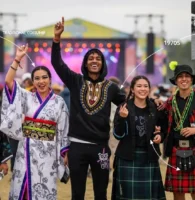Discover how migration, social media, and globalization are transforming traditional food rituals — blending flavors, reinventing celebrations, and creating new global food identities.
When Tradition Meets TikTok — The Evolution of Food Rituals

Imagine this:
A Mexican-American family serves tamales with a side of kimchi at Christmas.
A Nigerian chef in London tops jollof rice with vegan cheese for a multicultural Eid feast.
A teenager in Tokyo livestreams herself baking Diwali ladoos — learned from a YouTube tutorial.
This isn’t cultural confusion.
It’s cultural creativity.
As people move, connect, and share faster than ever, traditional food rituals are evolving — not disappearing, but adapting. Migration, media, and globalization aren’t erasing heritage. They’re remixing it.
See also Food as Offering: Honoring Ancestors and Deities Through Ritual Meals
Food as Offering: Honoring Ancestors and Deities Through Ritual MealsIn this article, we’ll explore how modern forces are reshaping the way we celebrate with food — turning kitchens into cultural crossroads and dinner tables into global stages.
Migration: Recipes That Travel — and Transform
When people move, they bring their food — and their food brings its story.
🧳 The Suitcase Cuisine Effect
Immigrants often hold tightly to food rituals as a way to stay connected to home. But over time — and across generations — those dishes start to change.
- Indian curry in the UK → Now served with Yorkshire pudding or naan pizza
- Chinese Lunar New Year dumplings in NYC → Stuffed with local cheese or kale
- Mexican tamales in Texas → Wrapped in banana leaves (borrowed from Central America) or made vegan
🌮 “My abuela’s mole recipe stayed the same… until we moved to California and discovered almond butter. Now it’s our family secret.”
See also💃 The Evolution of Traditional Costumes in Contemporary Festivals
These aren’t “inauthentic” recipes — they’re living traditions, shaped by new ingredients, new hands, and new contexts.
👨👩👧👦 Second-Generation Fusion
Children of immigrants often become culinary translators — blending their parents’ traditions with the flavors of their birthplace.
Result?
“Third Culture Food” — dishes that don’t fit neatly into one cuisine, but feel deeply personal:
- Thanksgiving turkey with jerk seasoning
- Sushi burritos for birthday parties
- Rosh Hashanah apple pie… made with miso caramel
Media & Social Platforms: Viral Traditions and DIY Rituals

Instagram. TikTok. YouTube. Food blogs.
Today, anyone with a phone can learn — and reinvent — a global food ritual.
📱 The “How To” Generation
Platforms like TikTok have turned obscure regional dishes into viral sensations:
- #BaklavaChallenge → Millions try folding filo for Eid
- #DiwaliSweets → Non-Indian teens bake ladoos for the first time
- #LunarNewYear → Dumpling-making tutorials go global
This isn’t appropriation — it’s participation. When done respectfully, it spreads appreciation… and sometimes, innovation.
🎥 “I learned to make mooncakes from a 60-second video. Now I host a mooncake party for my friends every year — even though I’m not Chinese.”
🎂 DIY Celebrations: Curating Your Own Rituals
Younger generations are less tied to strict religious or cultural rules — and more interested in creating meaningful moments.
Result?
Customized food rituals:
- “Friendsgiving” with dishes from everyone’s heritage
- Vegan Diwali feasts shared on Instagram
- “Spiritual but not religious” solstice dinners with global dishes
Food becomes less about dogma — and more about connection, creativity, and personal meaning.
Globalization: Supermarkets, Chains, and Shared Ingredients
You can now find miso in Minnesota. Halal chicken in Helsinki. Vegan cheese in Mumbai.

Global supply chains and supermarket diversity mean ingredients once “exotic” are now everyday — and that changes how rituals are practiced.
🛒 The Global Pantry Effect
Families adapt traditional recipes using what’s available — or what’s trending:
- Using coconut milk instead of dairy in Hindu fasting recipes
- Replacing ghee with olive oil in Jewish holiday dishes (for health or availability)
- Making gluten-free tamales for guests with dietary needs
This flexibility keeps traditions alive — even when the “original” ingredients aren’t.
🍔 Fast Food Goes Festive
Even global chains join the ritual remix:
- McDonald’s in India offers McAloo Tikki for Diwali
- Starbucks releases mooncake Frappuccinos in Asia
- KFC Japan’s Christmas chicken tradition (yes, it’s real — and wildly popular)
It’s commercial, sure — but it also shows how global brands localize rituals to stay culturally relevant.
Challenges: When Fusion Feels Like Erasure
Not all change is celebrated.
Some worry that fusion dilutes tradition — especially when:
- Sacred dishes are turned into “trendy snacks” without context
- Recipes are stripped of their stories (“This isn’t just curry — it’s my grandmother’s survival”)
- Corporations profit from cultural foods without honoring their origins
🚫 “It’s not fusion if you don’t credit the culture. It’s theft with extra sauce.”
The key? Respect, credit, and collaboration.
When fusion is done with humility — learning the story behind the dish, honoring its roots, and sharing credit — it becomes celebration, not erasure.
The Silver Lining: Food as a Bridge, Not a Barrier
Despite the challenges, the blending of food rituals has powerful upsides:
✅ Preservation through innovation — younger generations stay connected to heritage by remixing it
✅ Cross-cultural understanding — sharing food = sharing stories
✅ Inclusivity — dietary needs, mixed families, and global citizens find ways to belong
✅ Culinary creativity — some of the world’s most exciting dishes are born at cultural crossroads
🌐 “My table doesn’t have borders. It has flavors — and everyone’s invited.”
Real-World Examples: Fusion Rituals in Action
| Thanksgiving (USA) | Tofurky + kimchi stuffing + mango chutney | Honors heritage while including vegan, global, and health-conscious guests |
| Eid al-Fitr (Global Muslim) | Date-sweetened vegan cakes, Insta-worthy dessert tables | Keeps spirit of sweetness alive for new generations and dietary needs |
| Diwali (Indian diaspora) | Diyas + LED lights, store-bought + homemade mithai, fusion cocktails | Makes celebration accessible without losing meaning |
| Lunar New Year (Global) | Dumpling-making Zoom parties, red envelope NFTs, boba tea toasts | Connects scattered families through tech + tradition |
FAQs: Globalization and Food Rituals
❓ Is fusion cuisine ruining traditional food?
Not if it’s done with respect. Fusion can keep traditions alive by making them relevant to new generations and contexts.
❓ How can I celebrate a culture’s food ritual without appropriating it?
Learn the story behind the dish. Credit its origins. Support creators from that culture. And — when possible — celebrate with them, not just from them.
❓ Why do younger people change food traditions?
They’re not rejecting heritage — they’re adapting it to their reality: mixed families, global access, dietary needs, and digital lifestyles.
❓ Can a ritual still be “authentic” if it’s changed?
Yes. Authenticity isn’t frozen in time — it’s rooted in meaning. If the heart of the ritual (gratitude, remembrance, community) remains, it’s still real.
Conclusion: The Future of Food Rituals Is Fluid — and Flavorful
Globalization hasn’t killed tradition.
It’s given it new ingredients. New stages. New voices.
The tamale wrapped in a banana leaf.
The Diwali party with vegan ladoos and Spotify playlists.
The Christmas KFC bucket in Tokyo.
These aren’t signs of cultural loss — they’re proof of cultural resilience.
As long as people gather.
As long as stories are told over steaming pots.
As long as love is served on a plate…
…food rituals will keep evolving — deliciously, meaningfully, globally.





